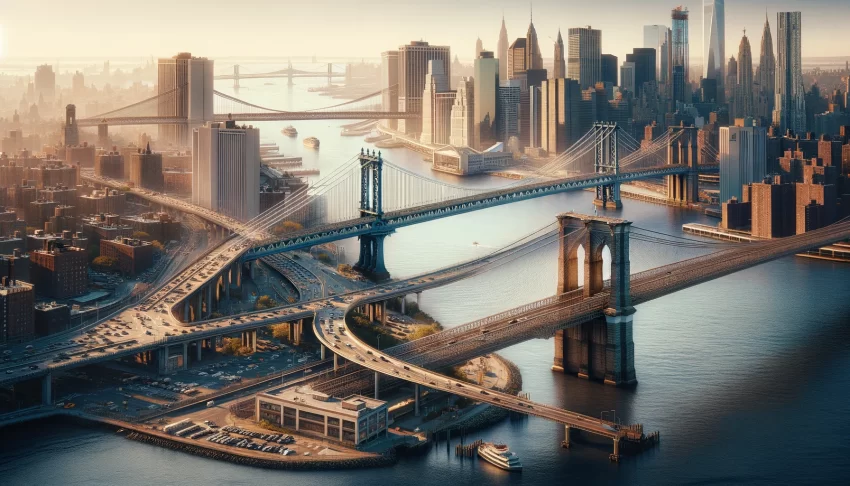| Listen to our audio presentation: Secret Santa Police Officer |
The history of bridges in the United States is a testament to human ingenuity, architectural innovation, and the relentless pursuit of connectivity. From humble wooden structures to awe-inspiring feats of engineering, bridges have played a pivotal role in shaping the nation’s infrastructure and facilitating its growth.
Early Beginnings: Wooden Bridges and Stone Arches
The story of American bridges began with simple wooden structures built by Native Americans and early settlers. These bridges were often rudimentary, constructed using logs or planks to span small creeks and rivers. As the nation expanded, the need for more durable crossings led to the construction of stone arch bridges, inspired by Roman and European designs. One notable example is the historic Old Bridge in Philadelphia, built in 1697, which showcased the durability and aesthetic appeal of stone construction.
The Iron Age: Emergence of Metal Bridges
The 19th century marked the advent of the Industrial Revolution, and with it, the emergence of iron and steel as primary materials for bridge construction. The use of cast iron and wrought iron allowed for the creation of stronger, longer-span bridges. The iconic Bollman Truss Bridge in Maryland, built in 1852, exemplifies this era with its innovative use of wrought iron.
The Golden Age of Steel: Suspension and Cantilever Bridges
The late 19th and early 20th centuries witnessed the golden age of steel bridges in the United States. Engineers pushed the boundaries of design with the introduction of suspension bridges and cantilever bridges. The Brooklyn Bridge, completed in 1883, became a symbol of American ingenuity and a marvel of its time with its unprecedented span and the use of steel cables. Similarly, the Williamsburg Bridge and the George Washington Bridge set new standards for bridge design and engineering.
Modern Marvels: Cable-Stayed and High-Tech Bridges
The latter half of the 20th century and the early 21st century have seen the rise of cable-stayed bridges and the incorporation of advanced materials and technology. The Sunshine Skyway Bridge in Florida and the Leonard P. Zakim Bunker Hill Memorial Bridge in Massachusetts are examples of the elegant design and structural efficiency of cable-stayed bridges. The use of computer-aided design and cutting-edge materials like carbon fiber has further revolutionized bridge construction.
Bridging the Future:
The history of bridges in the United States is a reflection of the nation’s journey from a land of scattered communities to a connected, modern society. Each era brought new materials, designs, and technologies that transformed the landscape and facilitated the movement of people and goods. As we look to the future, bridges will continue to evolve, incorporating sustainable materials and smart technologies, ensuring their role as vital arteries in the nation’s infrastructure for generations to come.
Here is a list of some of the most noteworthy bridges in the United States:
- Golden Gate Bridge (San Francisco, California): An iconic suspension bridge known for its striking red color and beautiful setting at the entrance of San Francisco Bay.
- Brooklyn Bridge (New York City, New York): A historic suspension bridge connecting Manhattan and Brooklyn, celebrated for its distinctive Gothic arches and cables.
- Mackinac Bridge (Michigan): A long suspension bridge connecting Michigan’s Upper and Lower Peninsulas, known as “Big Mac” or “Mighty Mac.”
- George Washington Bridge (New York City, New York): A double-decked suspension bridge spanning the Hudson River, connecting Manhattan and New Jersey.
- Sunshine Skyway Bridge (Tampa Bay, Florida): A cable-stayed bridge known for its striking yellow cables and sleek design, spanning Tampa Bay.
- Chesapeake Bay Bridge (Maryland): A major dual-span bridge that connects Maryland’s eastern and western shores across the Chesapeake Bay.
- New River Gorge Bridge (West Virginia): A steel arch bridge spanning the New River Gorge, known for its impressive height and annual BASE jumping event.
- Bixby Creek Bridge (Big Sur, California): A picturesque open-spandrel arch bridge along the Pacific Coast Highway, known for its scenic location and architectural beauty.
- Lake Pontchartrain Causeway (Louisiana): A long bridge stretching across Lake Pontchartrain, recognized as one of the longest continuous bridges over water in the world.
- Huey P. Long Bridge (New Orleans, Louisiana): A truss cantilever bridge carrying both rail and automobile traffic over the Mississippi River in New Orleans.

